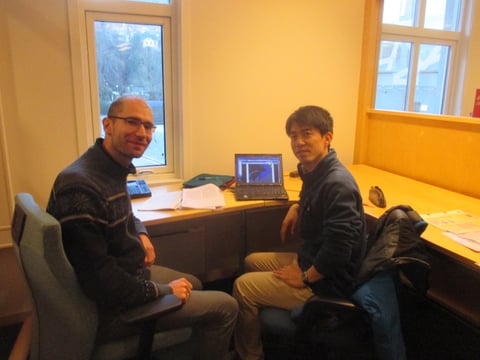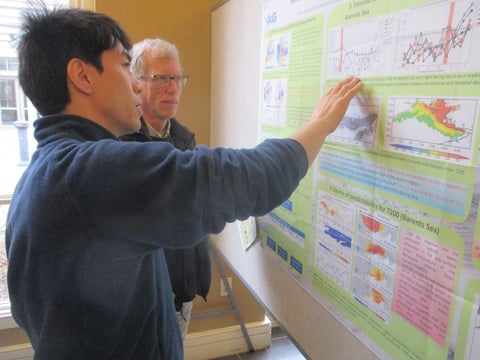With financial support from ArCS’ program for overseas visits by young researchers, I stayed at the Nansen Environmental and Remote Sensing Center (NERSC) in Bergen, Norway from February 6 to 11, to learn the TOPAZ4 data assimilation system and discuss my future work on the predictability of summertime sea ice in the Arctic Ocean.
During this visit, Dr. Laurent Bertino, the main developer of the TOPAZ4 data assimilation system, hosted me and arranged my logistics and accommodation. The NERSC is a major Arctic research institution affiliated with the University of Bergen, and is prominent in the fields of ocean circulation and sea ice dynamics and its predictability in and around the Arctic Ocean. They are looking into these processes from the different aspects including remote sensing technique, numerical simulation, data assimilation and ice-ocean interaction.
The NERSC owns a guesthouse available for external researchers who make either a short or long stay to conduct collaborative studies with the staffs of NERSC. During this visit, I also stayed at this facility and shared a room with a coastal oceanographer from the University of Helsinki. Although this is the first time for me to share a room with someone unfamiliar, it was a very good opportunity for me to discuss with a researcher of a different field of study and culture.
During this visit, I had an opportunity to talk about my study at the regular seminar held at the NERSC and presented the results of the analyses on sea ice thickness from the TOPAZ4 reanalysis data. In this seminar, I received many insightful comments from Dr. Bertino and colleagues in his research group (Fig. 1). Also, Dr. Jiping Xie, a researcher of the data assimilation group, showed their recent study on the evaluation of the sea ice thickness of the TOPAZ4 reanalysis data. Through the discussions with them, I was able to improve my knowledge about the TOPAZ4 data assimilation system. Since the period of my visit was too short, I was not able to learn the whole system. However, I think I took the first step toward furthering my research and made connections with the Arctic scientists.
Prior to this visit, I attended the US CLIVAR workshop 2017 (Arctic change & its influence on mid-latitude climate & weather), which was held at Georgetown University in Washington D.C., to present our recent studies on the predictability of wintertime sea ice in the Barents Sea and the Bering Sea [Nakanowatari et al. 2014, 2015], which is considered to be a major factor in the recent severe winter in the mid-latitudes. During this workshop, the possible causes of recent severe winter events frequently occurring in Eurasian continent and the North America were mainly discussed based on the observational analyses and atmospheric model experiments. In particular, it was shown that the numerical model experiments have large uncertainty about their results and other factors such as the influence of atmospheric response to the ocean heat flux from the Gulf Stream were also reported by many researchers. In my working group, the difference in the atmospheric response to the sea ice condition was discussed in terms of the AGCM experiment design such as the boundary condition. Consequently, the inter-comparison project between these AGCM experiments based on standard boundary conditions was agreed upon. Thus, it is expected that the relationship between the recent severe winter and the decrease in the sea ice in the Arctic Ocean will be clarified in the future.
In the poster session (day 2 of workshop), many researchers such as Dr. Jamses Overland, a famous researcher of NOAA, came to my poster board and listened to my talk with much interest (Fig. 2). In particular, a researcher from AWI knew my name and was interested in our studies. Such comments were a great encouragement to me.
Takuya Nakanowatari(NIPR)
 Figure 1. Discussion with Dr. Bertino at the NERSC. Dr. Bertino is on the left.
Figure 1. Discussion with Dr. Bertino at the NERSC. Dr. Bertino is on the left.

Figure 2. Poster session during the US CLIVAR workshop.




